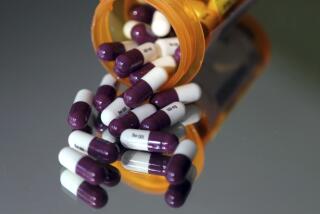Promising AIDS Drugs Are Being Tested but No Quick Breakthroughs Are Seen : Medicine: Scientist sees no large research harvest this year but reports that ‘the crop is still growing.’
FLORENCE, Italy — Although promising new AIDS drugs are being tested, leading researchers are resigned to a lack of dramatic advances in treatment for the near future.
Scientists here at the International Conference on AIDS remain optimistic about the prospects for new medications, including some highly touted ones that are only now reaching the stage of human testing. But it is far too soon to say whether the promise of any of these medications will be fulfilled.
“We are in an interim period right now in which there are a lot of very exciting things that are coming out of the laboratory, but at the same time some of them are not really (being tested on humans) yet,” said Dr. Robert Yarchoan of the U.S. National Cancer Institute.
“This year is not a large harvest in terms of clinical research,” said Dr. Daniel Hoth, the director of the AIDS program at the National Institute of Allergy and Infectious Diseases. “That doesn’t mean that there is no progress. It just means that the crop is still growing.”
This reality is disappointing for people infected with the human immunodeficiency virus and the physicians who care for them. But it reflects the cyclic nature of medical progress.
Definitive trials to establish the effectiveness of a new medication for acquired immune deficiency syndrome “really take a long time,” Yarchoan said. “This is frustrating for everyone.”
In retrospect, 1989 was a big year for AIDS treatment advances. Early in that year, aerosol pentamidine, a drug to prevent AIDS-related pneumonia, became widely available. In May, the first promising results for DDI, or dideoxyinosine, were announced.
And in the late summer, two large tests of AZT, which had already been approved for the treatment of AIDS patients, showed that the medication helped to prevent the development of AIDS in asymptomatic HIV-infected individuals as well as those with pre-AIDS symptoms.
But in 1990 and so far in 1991, the visible rate of progress has slowed. A key reason is that the very success of drugs such as AZT and preventive medications for Pneumocystis carinii pneumonia have made it more difficult to establish the effectiveness of newer medications. New substances must be shown to work better than current therapy.
Improved treatments for AIDS-related infections of the brain and other vital organs continue to save lives. But as patients live longer with profoundly impaired immune systems, they are more likely to die from lymphomas and other tumors, as several groups of researchers have emphasized this week.
Two drugs that are similar to AZT--DDI and DDC (dideoxycytidine)--are now taken by thousands of AIDS patients in the United States, primarily those who are unable to take AZT or who fail to respond to it.
But DDI and DDC also have side effects. Both can cause painful nerve inflammation. DDI occasionally causes life-threatening inflammation of the pancreas.
The overall role of DDI and DDC in AIDS treatment is not clear. “It is surprising how little we know about these two drugs,” said Dr. Ian Weller, a British AIDS expert, in a plenary address Tuesday.
This week, the new results that have been presented here for both DDI and DDC are very preliminary.
Combination therapy with DDI and AZT appears to cause “similar if not better” increases in the number of key immune system cells known as T-4 lymphocytes than have been seen in patients taking AZT alone, according to a presentation Tuesday by Dr. Ann C. Collier of the University of Washington in Seattle.
But the 24-week study of 55 patients was not large enough or long enough to answer the big question: Do the HIV-infected patients who receive this combination therapy live longer and healthier lives?
In addition, researchers at the National Cancer Institute and USC Medical Center in Los Angeles reported encouraging initial results with the use of DDI in HIV-infected children.
At a pre-conference symposium, Dr. Margaret Fischl of the University of Miami discussed a one-year government-sponsored study of 56 HIV-infected patients who received combination therapy with DDC and AZT.
According to Fischl, the results suggested that the combination of DDC and AZT was more beneficial than AZT alone. But, again, this conclusion was based on the greater increases seen in the number of T-4 cells with the drug, not on improvements in the overall health or survival of patients.
Significant new information about these two drugs may be available later this year, after the results of continuing trials involving hundreds of patients are reviewed, according to Hoth, the federal government AIDS official.
In addition, in July, an advisory committee to the U.S. Food and Drug Administration will discuss whether there is sufficient favorable data to recommend the approval of DDI for prescription sales.
On the horizon are several new classes of AIDS medications.
One class is made up of the so-called TIBO compounds. Like AZT, TIBO drugs interfere with the key enzyme called reverse transcriptase, which allows the AIDS virus to reproduce itself. But they are not chemically related to AZT and work differently at a molecular level.
Another new class of AIDS drugs are protease inhibitors. These drugs interfere with an enzyme that has a crucial role in the assembly of new AIDS virus particles in the body. Manufacturers are developing these medications.
Dr. Robert C. Gallo of the U.S. National Cancer Institute, a co-discoverer of the AIDS virus, is studying SP-PG, a sulfur-contained polysaccharide produced by a soil bacteria. In laboratory mice, SP-PG “has very interesting positive effects” against the AIDS-related cancer known as Kaposi’s sarcoma, according to Gallo. For instance, it can dramatically shrink the tumors in mice.
But SP-PG is unlikely to be tested in humans until Daichi, the Japanese company that makes it, can produce large amounts of the compound in pure form, Gallo said.






